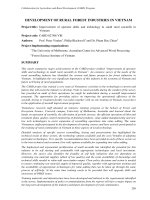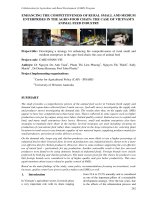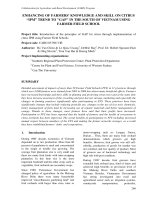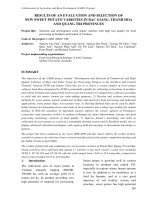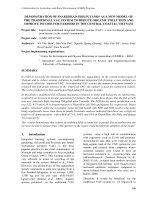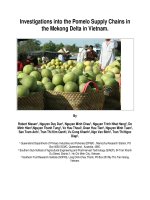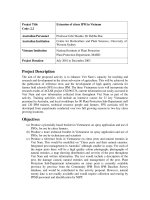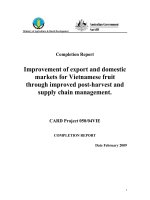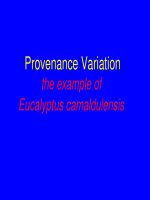Báo cáo nghiên cứu nông nghiệp " Introduction of the principles of GAP for citrus through implementation of citrus IPM using Farmer Field Schools " pptx
Bạn đang xem bản rút gọn của tài liệu. Xem và tải ngay bản đầy đủ của tài liệu tại đây (13.65 MB, 12 trang )
Collaboration for Agriculture and Rural Development
(CARD)
Program
268
ENHANCING OF FARMERS' KNOWLEDGE AND SKILL ON CITRUS
“IPM” TREND TO "GAP" IN THE SOUTH OF VIETNAM USING
FARMER FIELD
SCHOOL
Project title:
Introduction of the principles of GAP
for citrus through implementation of
citrus IPM using Farmer Field Schools
Project code
: CARD 037/06 VIE
Author(s):
Ho Van Chien & Le Quoc Cuong
1
, Debbie Rae
2
, Prof. Dr. Robert Spooner
-
Hart
& Oleg Nicetic
2
, Tran Van Hai & Duong Minh
3
Project Implementin
g organisations:
1
Southern Regional Plant Protection Center, Plant Protection Department
2
Centre for Plant and Food Science, University of Western Sydney
3
Can Tho University
SUMMARY
Detailed assessment of impacts of more than 50 Farmer Field Schools
(FFS) in 11 provinces through
which over 2,000 farmers were trained from 2005 to 2006 has shown many beneficial effects. Farmers
have increased knowledge and their skills in planting and protecting citrus trees and at the same time
they have increase awar
eness of the recording and post
-
harvest storage, marketing and especially the
changes in farming practices significantly after participating in FFS. These practices have been
significantly changes that include reducing pesticide use, changes in the use of
less toxic chemicals,
better management of farm land by increasing use of organic materials and better management of
canopy. Thanks to these changes, most farmers have said that their profits have increased.
Participation in FFS has been reported that the
health of farmers and the health of ecosystems in
citrus orchards has been improved. The social benefits of participation in FFS including increased
mutual respect between members of the FFS and making the farmer networks stronger, as a result
they have es
tablished farmers’ clubs and cooperatives.
1.
Introduction
During 1980’ decade, economics of Vietnam
depended on to rice production. More than 80
percent of population i
s rural and concentrated
in the single or double rice growing. The
average fruit plantation size is very small and
there are many fruit kinds with inter
-
cropping
plantation. In this time rice is the most
important foodstuff and the other crops such as
vege
tables, fruit orchards are secondary crops.
Since 1980, Vietnamese Government has
changed policy of agriculture. In the Mekong
River Delta there were many households
improved “miscellaneous gardening land” and
fruit orchards with larger than sizes, inter o
r
mono
-
cropping such as: Longan, Guava,
Durian… Thus, there are many fruit orchard
demonstrations which growers get high
benefits. However, fruit grower was still self
-
subsidy, production of goods for market was
not oriented, and low quality of product. Mo
st
of growers use of backward technology and
high risk with pest condition.
During 1990’ decade, fruit growers have
extended fruit orchard area, kind of fruits and
achieved high benefits in provincial level of
the Mekong River Delta and southern
Vietnam. B
esides, Vietnamese Government
has strong investigated into rural and
agricultural sector such as: irrigation systems,
countryside transportation, pesticides,
CARD 037/06
–
Introducing GAP for citrus through FFS
269
fertilizers, etc…Particularly, extension agency
network on plant protection for advance
technology
application on fruit production to
the growers. During this period, the problems
for the citrus growers were not stable price and
most of growers have grown other fruit
orchard concentrations such as: Longan,
Rambutan, Durian… On the other hand, the
pest
situation on citrus more increase
population because high input fertilizers and
pesticide applications. The main insect
-
pests
and diseases caused of yield loss such as: Leaf
minor, Mites, Fusarium, Phytophthora,
Tristeza. Particularly, “Greening”
(Huanglon
gbin) disease has infected large
area and disease sources still remain in
practices. Greening disease is very difficult to
control because the insect vector (Diaphorina
citri) with long distance migration.
Today, total citrus growing area is around
68.00
0ha in the Mekong River Delta. The
citrus growers try to learn more new
technology of cultural method, good quality
variety and free
-
disease, “Linking
Environment And Farming”, “IPM” trend to
“GlobalGAP” base on “VietGAP” in order to
have good quality, saf
e products and “oriented
market”.
The research of two projects (036/04 VIE) and
(037/06 VIE) from UWS and Vietnamese
partners from Plant Protection Department and
Can Tho University.
The major scope of the pilot project conducted
from 2001
-
2003 was t
o develop a curriculum
for training in citrus IPM following the Farmer
Field School model and provide learning
resources primarily for trainers in the form of
books. The second AusAID CARD project that
focuses on Citrus IPM trend to “GlobalGAP”
based on “V
ietGAP” from 2006
-
2009 in
southern Vietnam. Current project is to
implement IPM is directed by "GlobalGAP"
and in the cooperative is typical practice
"GlobalGAP." Binh Minh District in Vinh
Long Province (Mekong Delta), since 2005 we
have been guiding for
12 FFS, in which 9 FFS
were funded by AusAID CARD and 3 FFS
were funded by the Provincial Government.
The results to date are that nearly 150 hectares
of the 250 hectares of citrus this district have
adopted IPM. The farmers have joined the
cooperative and
My Hoa Cooperative has been
funded by Metro to improve warehouses and
providing technical guidance on post
-
harvest
preservation is fundamental. Currently farmers
here are selling products to Metro and
exporting to the Netherlands, France, and
Russia (abou
t 120 tons since the last half year).
Twenty
-
six farmers from the Cooperatives
have completed FFS in 2007 and will be
granted with Global GAP certification later
this year. We had convinced local governments
to continue funding for the farmers to improve
t
heir latrines (toilets), as this is the main
obstacle among GAP standards.
Ho Van Chien
,
Le Quoc Cuong, Debbie Rae, R
obert Spooner
-
Hart
,
Oleg Nicetic, Tran Van Hai
&
Duong Minh
270
The evaluation results of the current project
was conducted in 2010 so in this report we will
present the outcomes of the project 2.
2.
Research contents and methods
Methodology fo
r impact evaluation of FFS is
still under development and as yet there is no
agreed methodological framework (van den
Berg and Jiggins 2007). It is generally agreed
however, that assessment of the FFS impact is
complex because of the diversity of impact
pa
rameters and the different perspective held
by stakeholders on what constitutes impact
(van den Berg and Jiggins 2007). Impact
assessments presented in this report and the
methodology used is in line with the impact
assessments conducted previously by othe
r
donors, government and non
-
government
agencies. Assessments included self
-
evaluation
by farmers and self
-
evaluation by other project
stakeholders in order to ensure that evaluated
were those that were most relevant to the
primary stakeholders. This metho
d is that
parameters impacts of FFS are sometimes
confounded by temporal variations such as
differences in many provinces, on different
citrus species (oranges, mandarins and
pomelo), in yield and market prices from year
to year.
However, the baseline stu
dy was a very
important awakening experience for both the
Australian and key Vietnamese project
personnel that allowed us to better understand
needs of citrus farmers in different parts of
Vietnam.
The focuses on Citrus IPM trend to
“GlobalGAP” based on “
VietGAP”, selection
of 30 farmers who graduated “FFS” and their
citrus orchards were grown nearby together
have carried out.
2.1.
Research Contents
2.1
KAP survey and analysis
A KAP (knowledge, attitudes and practices)
survey was conducted with all pa
rticipants
who attended FFS. The pre
-
survey was
conducted at the commencement of FFS and
the post
-
survey conducted at the last FFS
meeting. Printed surveys were provided to the
FFS participants by trainers, who then read and
explained each question and all
owed time for
farmers to write down their individual
responses. Completed surveys were collected
by the trainers and returned to the Southern
Regional Plant Protection Centre for analysis.
All answers were coded and entered into an
Excel spreadsheet and th
en analysed using
SPSS (V11.5). Surveys were conducted with
FFS participants from 8 provinces in the
Mekong Delta (MD) in both 2005 and 2006
and from 4 provinces in the Central Coast
(CC) in 2005 and 3 in 2006. All analyses were
conducted on data aggregate
d by region
(Mekong Delta and Central Coast).
2.2
Assessment of economic, social and
environmental impacts using
interviews
As citrus is a perennial tree crop with a year
-
long growing season it is not possible to assess
impacts of FFS within the timefram
e of FFS
itself. Economic, social and environmental
impacts were therefore assessed one year after
the completion of FFS using semi
-
structured
interviews with individual farmers. Interviews
were conducted with at least 5 farmers from
each province who part
icipated in FFS one
year after the completion of their training. A
semi
-
structured approach was used to allow
the farmers to identify changes in their
agricultural practices, major economic
impacts, changes in their environment and to
describe the impact o
f FFS on their family life
and community interactions. Notes were
recorded under the major categories of: change
in practice; economic impacts, social impacts
and environmental impacts. In each village that
was visited, groups of farmers were also
surveyed
to determine their attitudes towards
pesticide use. The group surveys consisted of
seven questions and were conducted by
reading each survey question to the group of
farmers and asking for a show of hands to each
of the three possible responses (not true,
maybe true, definitely true). Farmers were
required to choose the response that best
represented their attitude, and the number of
farmers selecting each response was recorded
for each question.
CARD 037/06
–
Introducing GAP for citrus through FFS
271
2.3
Comparative analysis of net profit
from citrus product
ion and the cost of
FFS
2.4
Survey of major beneficiaries
Key personnel from the major organizations
involved in the project were asked to complete
a survey on their impressions of the impacts of
the project.
3.
Research results and discussions
3.1
KA
P survey and analysis
In the Mekong Delta (MD) region FFS
participants were surveyed from Tien Giang,
Ben Tre, Dong Thap, Vinh Long, Tra Vinh,
Can Tho, Hau Giang and Soc Trang provinces
in 2005 and 2006. A total of 1061 pre and post
surveys were analysed f
rom 530 farmers in
2005 and 2181 pre and post surveys were
analysed from 1059 farmers in 2006. In the
Central Cost (CC) region FFS participants
were surveyed from Khanh Hoa, Binh Dinh,
Quang Nam and Nghe An provinces in 2005
and a total of 360 pre and post
surveys were
analysed from 180 farmers. In 2006
participants were surveyed in Khanh Hoa,
Binh Dinh and Nghe An provinces with a total
of 600 pre and post surveys being analysed
from 300 farmers.
Citrus growers in MD were more experienced
in growing citru
s with an average of 7 years
experience in comparison with 5.3 years of
experience of CC farmers. A majority of
farmers in both regions belonged to Farmers
Associations with 58% and 63% being
members in the MD and CC respectively. In
MD the dominant citrus
variety was pomelo
(34.9%) followed by orange (32.7%),
mandarin (22.5%) and lime (9.9%). The
commonly used classification of citrus in the
MD, which includes the citrus variety “King
Orange” as an orange, was used in this survey.
However, King oranges are
botanically closer
to mandarins. If King oranges were grouped
with Tieu mandarins, then together they would
be the dominant group of citrus in MD
followed very closely by pomelo. In CC
orange is the dominant citrus variety grown by
farmers (41.0%) followe
d by lime (24.4%),
pomelo (23.8%) and mandarins (10.8%). In the
MD mandarin and oranges are planted at an
average density of 1600 trees per hectare
(2.5x2.5) and pomelo at density of 493 trees
per hectare (4.5x4.5). In the CC mandarins are
planted at an av
erage density of 714 trees per
hectare (3.5x4), oranges at 550 trees per
hectare (4x4.5) and pomelo at 330 trees per
hectare (5.5x5.5).
In MD most of the planting materials were
produced by farmers themselves (46.1%) or
sourced from neighbours (16.3%) mak
ing a
total of 62.4%. Only 8.7% of respondents
planted certified planting materials sourced
from institutes or government run nurseries
(variety centres) (5.3%) and private nurseries
(3.4%). More than a quarter of respondents
(28.9%) did not know the origi
n of their
planting material. The farmers that did not
know the source of the planting material
probably bought it from boat traders who sail
the canals selling plant material produced by
farmers in other districts or provinces. In the
CC much more plantin
g material comes with
certification from institutes or government run
nurseries (variety centres) (20.5%) and private
nurseries (16.7%) making a total of 37.2%.
Farmers produced 26.5% of their planting
materials by themselves and 14.9% they
bought from the
ir neighbours making a total of
41.4%. The remaining 21.4% of respondents
did not know the origin of their planting
material.
In both regions the use of mineral fertilisers
was very high, with 95% of farmers reporting
their use in the MD and 88% in the CC
. Use of
organic fertilizers was higher in the CC with
91% respondents reporting their use, compared
to 60% in the MD. However use of foliar
fertilisers was higher in the MD where 51%
respondents used foliar fertiliser and only 24%
of respondents used foli
ar fertiliser in the CC.
The average number of pesticide sprays
applied per year in the MD at the
commencement of FFS in 2005 was 7 and it
was reduced to 6.5 after FFS was completed.
In 2006 the number of sprays pre
-
FFS was 7.7
and after FFS the average nu
mber of sprays
was reduced to 6.0. In the CC in 2005 the
average number of sprays pre
-
FFS was 3.3 and
it increased to 4 after FFS, while in 2006 CC
Ho Van Chien
,
Le Quoc Cuong, Debbie Rae, R
obert Spooner
-
Hart
,
Oleg Nicetic, Tran Van Hai
&
Duong Minh
272
average number of sprays was 5 before FFS
and it was reduced to 4 after FFS. The number
of sprays applied in
Dong Thap province is
much higher than elsewhere with 20 sprays per
year not being unusual, but after FFS the
number of sprays was reduced to 12
-
15 per
year. The number of farmers that used mineral
oil was increased from 38% pre
-
FFS to 52.2%
post FFS in t
he MD and from 16.9% pre
-
FFS
to 61.1% post
-
FFS in the CC. That indicates a
change from more environmentally destructive
pesticides towards more sustainable pesticides.
The majority of farmers believe that training,
field days and seminars are the best way
of
communicating new knowledge to farmers
with 46.1% farmers nominating these methods
in the MD and 54.9 % in the CC. Only 11.2%
farmers in the MD and 8.9% in the CC thought
that demonstration sites are a good way to
learn new technologies.
Different pat
terns of change of beliefs about
plant nutrition and citrus growing were
observed between the two regions. There was a
significant increase in agreement that planting
of disease free
-
citrus seedlings will result in
higher yield for CC farmers but there was
no
change in beliefs for MD farmers after
attending FFS. The level of disagreement to
the statement that higher density citrus
plantings will give higher yields was
significantly higher for MD farmers but
unchanged for CC farmers. There was a
significant
decrease in agreement to the
statement application of foliar fertilizer will
increase yield for MD farmers and a significant
increase in agreement for CC farmers after
attending FFS.
The change in beliefs about major pests and
diseases were relatively c
onsistent between
locations. There was a significantly increased
awareness of effective methods for
management of citrus greening disease and
that psyllids are the major vector of the disease
in both regions. There was also increased
agreement that leafmin
er damage can
exacerbate canker disease, although this
increase was not significant for MD farmers in
2005. In the CC region there was a significant
increase in agreement that trees infected with
leafminer will give lower yield while beliefs
remained uncha
nged in the MD region.
Although famers generally agreed with the
statement that aphids must be controlled by
insecticide as soon as they are detected on the
trees, in 2006 there was a significant decrease
in agreement for MD farmers and a significant
incre
ase in agreement for CC farmers. These
differences reflect the effect of different
situations between locations and different
emphases of trainers.
Participation in FFS most strongly influenced
beliefs about pest control methods with a
significant change
in all but one case. All
farmers became more aware of the damage
pesticides can cause to human health and
natural enemies. All farmers also increased
their level of agreement that pesticides can
cause pest resurgence and decreased their
agreement that app
lications of pesticide will
increase the yield and that advanced farmers
use a lot of pesticide. Greening disease was the
major concern of farmers in the MD region
and this did not change after participation in
FFS, although the priority of other pests and
diseases did change slightly. In 2005 farmers
in the CC region were also most concerned
about greening disease both before and after
participation in FFS. The second highest
concern was root rot and the level of concern
did not change. However, in 2006 fa
rmers in
the CC region were more concerned about
mites prior to participation in FFS and they
became more concerned about leafminer after
attending FFS.
CARD 037/06
–
Introducing GAP for citrus through FFS
273
Table 1
.
Beliefs of FFS participants about plant nutrition and citrus growing
Knowledge, attitu
de and
practices (KAP) survey
question
Average agreement score
1
Mekong delta
2005
Central Coast
2005
Mekong delta
2006
Central Coast
2006
Pre
Post
Pre
Post
Pre
Post
Pre
Post
Planting of diseases
-
free
citrus seedlings will result
in higher yield
4.20
4
.16
4.34
4.52
*
4.24
4.28
4.08
4.45
**
Higher density citrus
plantation will give
higher yield
2.46
2.20
**
2.01
2.07
2.29
2.00
**
2.23
2.18
Higher rates of mineral
fertiliser will result in
higher yield
2.95
2.79
*
3.27
3.16
*
2.95
2.61
**
3.17
3.34
*
Applica
tion of foliar
fertiliser will increase the
yield.
3.64
3.50
*
3.76
3.98
*
3.73
3.41
**
3.55
4.12
*
* significance at 0.05%; ** significance at 0.01%
1
Figures represent mean score: a score between 0 and 2.50 indicates disagreement with the statement,
with a
lower score indicating a higher level of disagreement; a score between 2.50 and 3.50 indicates
that respondents cannot make up their mind or that about equal number of respondents agree and
disagree with the statement; a score between 3.5 and 5 indicates t
hat respondents agree with the
statement, with a higher score indicating a higher level of agreement.
Table 2.
Beliefs of FFS participants about major pests and diseases
Knowledge, attitude and
practices (KAP) survey
question
Average agreement score
1
M
ekong delta
2005
Central Coast
2005
Mekong delta
2006
Central Coast
2006
Pre
Post
Pre
Post
Pre
Post
Pre
Post
Citrus greening disease
can be managed using
disease free material and
orchard management
including control of
psylla
3.61
3.89
**
3.65
4.21
**
3
.78
4.12
**
3.36
4.41
**
Psylla is major vector of
citrus greening disease
4.23
4.45
**
3.92
4.44
**
4.14
4.64
**
3.98
4.70
**
Leafminer damage can
exacerbate canker
disease
3.73
3.82
3.54
4.11
**
3.57
3.80
**
3.45
4.02
**
Trees infected with
leafminer will giv
e
lower yield
4.24
4.18
3.94
4.30
**
4.11
4.09
3.95
4.30
**
Mite control is important
only in dry season
3.39
3.40
3.37
3.17
3.53
3.62
3.41
3.35
Aphids must be
controlled by insecticide
as soon as they are
detected on the trees
4.20
4.12
3.96
3.92
4.19
3.
95
**
3.72
3.96
**
* significance at 0.05%; ** significance at 0.01%
1
Figures represent mean score: a score between 0 and 2.50 indicates disagreement with the statement,
with a lower score indicating a higher level of disagreement; a score between 2.50 and
3.50 indicates
that respondents cannot make up their mind or that about equal number of respondents agree and
disagree with the statement; a score between 3.5 and 5 indicates that respondents agree with the
statement, with a higher score indicating a highe
r level of agreement.
Ho Van Chien
,
Le Quoc Cuong, Debbie Rae, R
obert Spooner
-
Hart
,
Oleg Nicetic, Tran Van Hai
&
Duong Minh
274
Table 3
.
Beliefs of FFS participants about pest control methods
Knowledge, attitude and
practices (KAP) survey
question
Average agreement score
1
Mekong delta
2005
Central Coast
2005
Mekong delta
2006
Central Coast
2006
Pre
Post
Pre
Post
Pre
Post
Pre
Post
Application of pesticide
will increase the yield
3.54
3.18
**
3.77
3.32
**
3.57
2.74
**
3.25
3.22
**
Using pesticide to
protect your trees can
harm your health
4.43
4.49
**
4.22
4.49
**
4.35
4.63
**
4.33
4.67
**
Use of pesticide can
c
ause pest resurgence
3.01
3.31
**
2.67
3.49
**
2.79
3.48
**
2.85
4.05
**
Use of pesticide will
decrease number of
natural enemies
(beneficial organism)
4.12
4.25
**
3.72
4.33
**
4.06
4.49
**
4.06
4.65
**
If trees are grown using
healthy planting material
and goo
d orchard
management then use of
pesticide may be
unnecessary
3.56
3.82
**
3.42
3.78
**
3.60
3.82
**
3.62
4.10
**
Most advanced farmers
use a lot of pesticide
2.63
2.28
**
2.24
1.92
**
2.52
2.08
**
2.19
1.77
**
Pesticide are cheap and
easy to apply
2.46
2.33
**
2
.20
1.80
**
2.63
2.15
**
2.27
2.37
* significance at 0.05%; ** significance at 0.01%
1
Figures represent mean score: a score between 0 and 2.50 indicates disagreement with the statement,
with a lower score indicating a higher level of disagreement; a score b
etween 2.50 and 3.50 indicates
that respondents cannot make up their mind or that about equal number of respondents agree and
disagree with the statement; a score between 3.5 and 5 indicates that respondents agree with the
statement, with a higher score in
dicating a higher level of agreement.
Table 4: Pests and diseases of major concern to farmers
Pest or disease
Proportion of farmers concerned with a particular pest or disease
Mekong delta 2005
Central Coast
2005
Mekong delta
2006
Central Coast
2006
Pre
Post
Pre
Post
Pre
Post
Pre
Post
Psylla
n/a
n/a
n/a
n/a
10.2
13.2
6.6
22.2
Scales (including
mealybugs)
14.7
9.7
3.9
1.1
15.8
12.8
11.8
4.2
Leafminer
4.6
4.7
15.1
15.6
4.8
3.6
20.7
23.9
Mites
11.9
12.6
15.6
10.1
12.7
13.7
21.8
19.7
Branch borer
0
0.4
15.6
11.7
0.8
0.1
5.2
2.8
Stink bug
1.5
1.2
2.8
2.2
1.6
0.8
0
0.7
Greening disease
1
43.9
49.4
27.4
31.8
27.0
31.9
17.0
15.5
Root rot
16.2
14.0
17.9
17.9
14.5
10.4
10.3
7.7
Scab
1.5
3.5
0
1.7
3.0
4.0
1.8
0.4
Others
5.7
4.5
1.7
7.9
9.6
9.5
4.8
2.9
1
Figure for 2005 includes farmers who answered greening disease and psylla, figure for 2006 includes
only farmers who answered greening disease
Collaboration for Agriculture and Rural Development
(CARD)
Program
275
3.2
Assessment of economic, social and
environmental impacts using
interviews
A total of 53 farmers were in
terviewed
individually and 132 interviewed in groups
from a total of 13 locations in November 2006.
3.2.1
Change in agricultural practices
At least one farmer in every province
mentioned a reduction in the number of sprays
applied but the most commonly
reported
change in spraying practice was a change to
different pesticide types. The most commonly
adopted new pesticide was PSO with 20
reports of oil being sprayed alone, and an
additional 8 reports of oil being mixed with
another agrichemical. Imidaclopr
id was the
next most commonly adopted pesticide with 16
reports of its introduction. Considerable
increase in the use of PSO was a result of the
strong support and involvement of PSO
producer Saigon Plant Protection Company
(SPC) from Ho Chi Minh City. SPC
supplied
products for use in FFS teaching trials but
more importantly the company organised
distribution of PSO to pesticide dealers in the
provinces where the FFS were conducted.
They coordinated their marketing effort with
project activities and printed
marketing
materials that incorporated the IPM program
developed in FFS trials. Although there were
only 11 reports of increased use of fertilizer
there were almost 4 times as many reports of
the introduction of organic fertilizers. A range
of different or
ganic materials mixed together
and sometimes with Trichoderma were used by
farmers. Other important change in agricultural
practice was the introduction of record keeping
and also the ability of farmers to recognise
pests and diseases and the introduction
of
monitoring.
3.2.2
Economic impacts
The dominant economic impact noted by
farmers who attended FFS in 2005 was a
decrease in the input costs. Over all provinces
a reduction in unspecified input costs was
mentioned 12 times, a reduction in pesticide
cost
s was mentioned 8 times and a reduction in
labour costs mentioned 5 times, resulting in
47% of farmers declaring a reduction in input
costs. Ben Tre was the only province in which
no mention was made of reduced input costs.
Increased yield was also frequen
tly noted with
only Vinh Long province farmers not reporting
an increase in yield. Although the farmers
often perceived increased yield and fruit
quality. There were fewer reports of increased
sale price of fruit and profit. It is not possible
to establish
what proportion of the increased
yield declared is due to changed management
practices and how much is due to seasonal
variation. As attribution of all of these
increases to the respondent’s participation in
FFS would be an overestimation of the benefits
of FFS, it has been assumed that participation
does at least partly contribute to the reported
yield and income increases.
3.2.3
Social impacts
The major social impact mentioned by farmers
was an increased sharing of knowledge and
experiences between far
mers who attended
FFS, neighbours, farmers’ club members and
within families. Only farmers from Dong Thap
province did not mention increased sharing of
knowledge and experiences, but they were all
members of citrus grower club and infect they
do share they
knowledge and experience and
make many collective decision that result in
management decision implemented in many
citrus orchards. Sharing of knowledge often
appeared to be linked with the reported
increased social activities related to drinking
coffee an
d rice wine. Attendance at FFS also
appears to have played an important role in
increasing grower club activities including
planning for and the establishment of farmer
co
-
operatives. Respondents also reported that
attending FFS assisted in the transition
of farm
management from father to son, husband to
wife and father to daughter.
3.2.4
Environmental impacts
A year after attending FFS and implementing
the practices they learned, many farmers
reported an increase of organisms in their
orchards with at l
east one farmer from every
province commenting on an increased number
of beneficial organisms. Farmers from Ben
Tre, Tien Giang, Can Tho and Soc Trang
mentioned either an increased number of fish
or that they were able to raise fish in the
Ho Van Chien
,
Le Quoc Cuong, Debbie Rae, R
obert Spooner
-
Hart
,
Oleg Nicetic, Tran Van Hai
&
Duong Minh
276
canals, where th
ey had not been able to
previously Other beneficial organisms that
were quite frequently mentioned were green
ants and honey bees. Six farmers noted an
improvement in the health of their trees and 5
commented that their own health had been
improved. Howeve
r, as part of the FFS training
involved identification of pests, diseases and
beneficial organisms, it is possible that some
of the perceived increases were a consequence
of an increased ability of respondents to
recognise beneficial organisms.
3.3
Compar
ative analysis of net profit
from citrus production and the cost of
FFS
3.3.1
Net profit of citrus production
As a part of semi
-
structured interviews,
farmers estimated their net income. It was very
difficult to verify their statements because they
did no
t keep accurate records of inputs and
outputs. However the interviewer did verify
with each farmer that they talking about net
income not total income. It was also verified
with each group of farmers that the estimated
net income represented the difference
between
total value of sold fruits and the costs of
immediate inputs like fertilizer, pesticide,
irrigation fees, cost of petrol used in
production, cost of hired labour, cost of
packaging and transportation to the market. In
calculating net profit, farme
rs did not include
costs of their own and their family labour
inputs, depreciation of equipment and orchard
or interest they paid on loans taken to support
production. The estimated net profit values
presented in Table 9 were recalculated from
the total va
lues provided by farmers for their
own orchard, to values per hectare to allow
comparison between farmers.
There is a high degree of specialisation in the
varieties of citrus grown within provinces in
Vietnam, with farmers in Dong Thap growing
almost excl
usively mandarins (Tieu) and
farmers in Nghe An provinces growing almost
exclusively oranges. Pomelo is grown in
majority of provinces and the area planted has
increased in the last decade. During surveys it
was observed that different varieties of citrus
seemed to provide very different returns to
farmers. In order to test the hypothesis that net
profit depended on the citrus variety grown,
statistical analysis was performed on net profit
data from different citrus species collected
from semi
-
structured in
terviews. In this
analysis the variety named ‘King Orange” in
Vietnamese was classified as mandarin
because botanically it is closer to mandarin
species. There was no significant species by
location interaction (F3, 19 =1.091, p=0.356)
and there were signi
ficant differences in the
value of net return provided to the farmers
between citrus species (F2, 28 =5.442,
p=0.010). Duncan’s test shows that pomelo
and mandarins provided higher net profit than
oranges. There were no statistically significant
difference
s between average property size on
which the citrus species were grown (F2, 28
=0.227, p=0.797). Mean net profit averaged
over citrus species and provinces was VND
78,620,000. Farmers growing mandarins in
average had net return of VND 100,000,000
followed
by pomelo growers with average
profit of VND 93,330,000. Farmers growing
oranges had average profit of only VND
37,880,000. Not surprisingly the highest
profits over 100,000,000 VND were recorded
in Tien Giang and Dong Thap provinces where
predominantly ma
ndarins are grown. Lowest
net profit was recorded in Ben Tre province.
There is high level of agreement between the
average net profit declared by farmers and
estimates given by provincial sub PPD with
only 2 provinces showing net profit recorded
in the in
terview to be outside the estimates
given by officials. In Ben Tre province
disagreement is due to very high variation
between incomes of interviewed farmers with
the coefficient of variation of 108% and in
Vinh Long province difference was due to the
smal
l sample size (only 2 farmers) and the net
profit given by officials being based on the
profit of advanced pomelo growers and not on
average farmers.
Compared with the net profit from rice the net
returns from citrus is 3 to 6 times higher. Data
also show
that returns for rice do not vary
between provinces nearly as much as the return
for citrus.
CARD 037/06
–
Introducing GAP for citrus through FFS
277
3.3.2
Relationship between the profitability
of citrus production and the cost of
FFS
Average profit per hectare was estimated at
VND 78,620,000 per year (= A$ 6
,401.19).
Average size of the farm was 0.69 ha. It could
be estimated that average net profit per farmer
household is VND 54,247,800. Cost of FFS
per participant was VND 867,361 (=A$ 70.62).
It can be estimated that cost of FFS per
participant represents o
nly 1.60% of their net
profit. It is fair to assume that just the saving in
the cost of pesticide as a result of reduction in
the number of sprays was higher than the
investment made in FFS.
Note:
1
During the duration of the project exchange
rates varied
from VND 11,372 for A$ 1 to
VND 13,200 for A$1 with the average value of
VND 12,282.09. The average exchange rate
value was used for all calculations presented in
this report.
2
Start
-
up costs do not include costs of
Australian scientists that participate
d in the
project. This project was a research project
with FFS being the object of the research so
the input of Australian staff in the actual
training program of TOT was minimal and did
not warrant inclusion in the cost of the
training.
Table 5
.
Averag
e size of citrus orchard and net profit per year
Province
N
Area
(ha)
Net profit
declared by
farmers
(VND/year)
Net profit
estimated by
province
officials
(VND/year)
Net profit
from rice
estimated by
provincial
officials
(VND/year)
K
h
anh Hoa
3
1.63
1
(0.
84)
2
38,330,000
1
(7,265,000)
2
Nghe An
4
0.85
(0.087)
44,000,000
(5,492,000)
30
-
50,000,000
10
-
12,000,000
Ben Tre
5
0.54
(0.137)
34,600,000
(16,798,000)
50
-
70,000,000
18,000,000
Tien Giang
6
0.73
(0.193)
134,330,000
(33,200,000)
100
-
150,000,000
Dong
Thap
4
0.31
(0.072)
115,000,000
(8,660,000)
100
-
120,000,000
Tra Vinh
2
0.58
(0.131)
83,250,000
(6,848,000)
Vinh Long
2
1.25
(0.250)
85,000,000
(15,000,000)
150,000,000
21,000,000
Can Tho
4
0.30
(0.041)
61,250,000
(13,288,000)
60
-
70,000,000
20
-
24,000
,000
Soc Trang
2
0.43
(0.075)
97,500,000
(52,500,000)
50
-
200,000,000
15,000,000
Total
34
0.69
(0.100)
78,620,000
(9,167,000)
30
-
200,000,000
10
-
24,000,000
3
1
Value is mean calculated from net profit stated by individual farmers in the semi
-
structured int
erview.
2
Value in parenthesis is standard error of mean
3
Net profit for rice per harvest was stated between 5,000,000 and 8,000,000 VND. In MD farmer can
have 3 harvests per year and in CC only 2 that makes significant difference in income per year for uni
t
area.
Ho Van Chien
,
Le Quoc Cuong, Debbie Rae, R
obert Spooner
-
Hart
,
Oleg Nicetic, Tran Van Hai
&
Duong Minh
278
Table 6.
Summary of the statistical analysis for difference in profitability between citrus species
Citrus
species
N
Area
(ha)
F test
4
Net profit
declared by
farmers
(VND/year)
Duncan
test
3
Mandarin
1
17
0.56
2
(0.085)
3
a
100,000,000
(14,660,000
)
a
Pomelo
6
0.68
(0.215)
a
93,330,000
(13,824,000)
a
Oranges
8
0.58
(0.114)
a
37,880,000
(6,346,000)
b
Total
31
0.59
(0.067)
82,680,000
(9,167,000)
1
Citrus variety in Vietnamese called ‘King Orange’ was counted as mandarin because botanically it is
closer to mandarin species.
2
Value is mean calculated from net profit stated by individual farmers in the semi
-
structured interview.
3
Value in parenthesis is standard error of mean
4
Treatments with the same letter do not differ significantly from each oth
er (p=0.05).
3.4
Survey of major beneficiaries
Seven personnel from research institutes,
extension agencies, private industry and non
-
government organizations completed surveys.
4.
Conclusions and recommendation
s
1.
Farmers increased their knowledge an
d
skills for many components of citriculture
including density of plantings, pruning,
plant nutrition and integrated pest
management. Farmer awareness about
spray application, record keeping, post
harvest and marketing was increased but
competence needs to
be further increased
in these areas. Farmers’ ability to critically
evaluate the process of production and
elements of the agro
-
ecosystem was
improved as a result of FFS.
2.
In the year following FFS, farmer practices
changed considerably resulting in a
red
uction of pesticide use, change of type
of pesticide used from broad spectrum
pesticides with high negative
environmental impacts to softer pesticides,
better soil management with increased use
of organic material and better canopy
management.
3.
A majority
of farmers claimed that as a
result of changed practices their net profits
increased, partly as a result of reduced
financial inputs and partly from increased
yield and fruit quality. These benefits
cannot be fully quantified because of
limited records kep
t by the farmers and the
restricted evaluation time of one year
which cannot fully account for temporal
variations in yield.
4.
Participation in FFS increased mutual
respect between FFS participants and also
increased the status of the farmers within
the
wider farming community.
Strengthened networks between farmers
facilitated the formation of farmers clubs
and cooperatives which include FFS
participants and members of the wider
farming community. Within these farmer
associations, FFS participants have t
aken
leadership roles.
5.
Although the level of female participation
in FFS, particularly in the south, was not
high, it resulted in major impacts on the
position of women in the family.
Attendance at FFS facilitated the transition
of farm management from me
n who had
employment outside the farm, to their
wives. As opportunities for finding
employment in sectors other than
agriculture increase in the future, the need
for women to take a leading role in
agricultural production will increase. This
project has de
monstrated that FFS training
CARD 037/06
–
Introducing GAP for citrus through FFS
279
can effectively assist women in this
process.
6.
There was also a small proportion of
children of farming families attending FFS
and although it may seem that their
attendance would offer similar
opportunities for transition of f
arm
management, as was seen with working
husbands and their wives, this potential
was not as effectively realised.
Generational hand over of management is
often the subject of contention, and it
seems that FFS was best able to facilitate
this when children
(sons) were provided
with a portion of the farm that they
independently managed.
7.
The number of beneficial insects observed
by the farmers and the use of predatory
green ants as biological control agents
increased, indicating that the health of the
agro
-
e
cosystem was improved. Some
farmers also reported that they were now
able to rear fish in the canals and that their
own health and health of their trees had
improved. Although these improvements
are difficult to quantify in monetary terms,
these changes in
dicate a considerable
improvement in the quality of farmers
lives.
8.
Management of the project and budget
needs to be able to quickly respond to
findings from the field and detected needs
of the farmers. If allocation of funds has to
be strictly used accordi
ng to the initial
budget, which is only based on the
prediction of needs by the research team,
or a long procedure is required to change
the initial budget allocations, then the real
needs of farmers established as result of
the participatory approach to r
esearch and
extension cannot be addressed within the
project timeframe.
9.
The cost of FFS per participant was
estimated at A$ 70.62, which was only
1.60% of the estimated average net profit
per hectare. Based on these estimates the
cost of FFS would be offs
et in just one
season due to the reduction of inputs and
increased yield. The cost of FFS in citrus
is similar to or only slightly higher than
that reported for rice, whereas returns for
citrus are 4 to 5 times higher than for rice.
Given the low investmen
t cost and
excellent return on investment in FFS, the
possibility that farmers contribute to the
cost of FFS through a small levy or
contribution should be considered in the
future, especially if farmers are members
of citrus clubs or cooperatives.
10.
To sust
ain benefits realised by FFS,
farming groups need financial support with
credit facilities enabling them to open
post
-
harvest operations in order to improve
market access. The pesticide registration
process, the suite of pesticides currently
registered for
use in citrus and
enforcement procedures need to be
completely overhauled. Without
government initiatives that recommend
and encourage use of new generation
pesticides that cause less disruption to the
environment, financial incentives to
pesticide compan
ies to register these
pesticides and incentives for farmers to
comply with registration, the use of old
generation pesticides will continue to
dominate.
